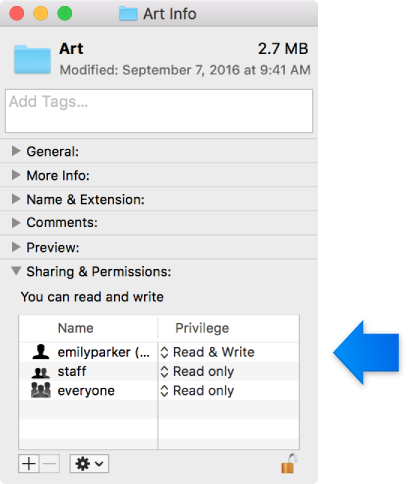Reading and Writing Files
When you first run the trial of Read&Write for the Mac you will have access to all the features on the toolbar, as below: After 30 days the Toolbar will revert to the Freemium licence, you will then only see the Text to Speech and Tran.
Scripts are often designed to write data to files such as logs or backups. The Standard Additions scripting addition contains a number of commands that make it possible to read and write files. Writing to a File. The handlers in Listing 16-1 and Listing 16-2 safely write data to disk, creating a new file if the targeted file doesn’t already. Aug 07, 2017 How Apple made the Photos app even more private in iOS 11. Charlie Sorrel/Cult of Mac. Instead of granting permission for an app to read and write to your Photos library, just so it can.
Scripts are often designed to write data to files such as logs or backups. The Standard Additions scripting addition contains a number of commands that make it possible to read and write files.
Writing to a File
The handlers in Listing 16-1 and Listing 16-2 safely write data to disk, creating a new file if the targeted file doesn’t already exist. Provide the text to write, a target file path, and indicate whether to overwrite existing content. If you choose not to overwrite existing content, then the text provided is appended to any existing content.
APPLESCRIPT
Listing 16-1AppleScript: Handler that writes text to a fileon writeTextToFile(theText, theFile, overwriteExistingContent)try-- Convert the file to a stringset theFile to theFile as string-- Open the file for writingset theOpenedFile to open for access file theFile with write permission-- Clear the file if content should be overwrittenif overwriteExistingContent is true then set eof of theOpenedFile to 0-- Write the new content to the filewrite theText to theOpenedFile starting at eof-- Close the fileclose access theOpenedFile-- Return a boolean indicating that writing was successfulreturn true-- Handle a write erroron error-- Close the filetryclose access file theFileend try-- Return a boolean indicating that writing failedreturn falseend tryend writeTextToFile
JAVASCRIPT
Listing 16-2JavaScript: Function that writes text to a filevar app = Application.currentApplication()app.includeStandardAdditions = truefunction writeTextToFile(text, file, overwriteExistingContent) {try {// Convert the file to a stringvar fileString = file.toString()// Open the file for writingvar openedFile = app.openForAccess(Path(fileString), { writePermission: true })// Clear the file if content should be overwrittenif (overwriteExistingContent) {app.setEof(openedFile, { to: 0 })}// Write the new content to the fileapp.write(text, { to: openedFile, startingAt: app.getEof(openedFile) })// Close the fileapp.closeAccess(openedFile)// Return a boolean indicating that writing was successfulreturn true}catch(error) {try {// Close the fileapp.closeAccess(file)}catch(error) {// Report the error is closing failedconsole.log(`Couldn't close file: ${error}`)}// Return a boolean indicating that writing was successfulreturn false}}
Listing 16-3 and Listing 16-4 show how to call the handlers in Listing 16-1 and Listing 16-2 to write text content to a file on the Desktop, replacing any existing content in the file.
APPLESCRIPT
Listing 16-3AppleScript: Calling a handler to write text to a fileset this_story to 'Once upon a time in Silicon Valley...'set theFile to (((path to desktop folder) as string) & 'MY STORY.txt')writeTextToFile(this_story, theFile, true)
JAVASCRIPT
Listing 16-4JavaScript: Calling a function to write text to a filevar story = 'Once upon a time in Silicon Valley...'var desktopString = app.pathTo('desktop').toString()var file = `${desktopString}/MY STORY.txt`writeTextToFile(story, file, true)

Listing 16-5 and Listing 16-6 show how Listing 16-1 and Listing 16-2 could be called to insert dated log entries into a log file.
APPLESCRIPT
Listing 16-5AppleScript: Calling a handler to write an entry to a log fileset theText to ((current date) as string) & space & 'STATUS OK' & returnset theFile to (((path to desktop folder) as string) & 'MY LOG FILE.log')writeTextToFile(theText, theFile, false)
JAVASCRIPT
Listing 16-6JavaScript: Calling a function to write an entry to a log filevar dateString = Date().toString()var desktopString = app.pathTo('desktop').toString()var text = `${dateString} STATUS OKnn`var file = `${desktopString}/MY LOG FILE.log`writeTextToFile(text, file, false)
In practice, this technique could be used to maintain a log when script errors occur. Listing 16-7 and Listing 16-8 are try statements, which can be wrapped around custom script code in order to log any script errors to a file in the ~/Library/Logs/ folder of the current user’s home directory.
APPLESCRIPT
Listing 16-7AppleScript: Example of a try statement that writes an entry to a log file when an error occurstry-- Your custom script code goes hereon error theErrorMessage number theErrorNumberset theError to 'Error: ' & theErrorNumber & '. ' & theErrorMessage & returnset theLogFile to ((path to library folder from user domain) as string) & 'Logs:Script Error Log.log'my writeTextToFile(theError, theLogFile, false)end try
JAVASCRIPT
Listing 16-8JavaScript: Example of a try statement that writes an entry to a log file when an error occurstry {// Your custom script code goes here}catch (error) {var errorString = `Error: ${error.message}nn`var logFile = app.pathTo('library folder', { from: 'user domain' }).toString() + '/Logs/Script Error Log.log'writeTextToFile(errorString, logFile, false)}
Reading a File
The handlers in Listing 16-9 and Listing 16-10 read the contents of a specified file.
APPLESCRIPT
Listing 16-9AppleScript: Handler that reads the contents of a fileon readFile(theFile)-- Convert the file to a stringset theFile to theFile as string-- Read the file and return its contentsreturn read file theFileend readFile
JAVASCRIPT
 Listing 16-10JavaScript: Function that reads the contents of a file
Listing 16-10JavaScript: Function that reads the contents of a filevar app = Application.currentApplication()app.includeStandardAdditions = truefunction readFile(file) {// Convert the file to a stringvar fileString = file.toString()// Read the file and return its contentsreturn app.read(Path(fileString))}
Listing 16-11 and Listing 16-12 show how to call the handlers in Listing 16-9 and Listing 16-10 to read a specified text file.
APPLESCRIPT
Listing 16-11AppleScript: Calling a handler to read the contents of a fileset theFile to choose file of type 'txt' with prompt 'Please select a text file to read:'readFile(theFile)--> Result: 'Contents of the chosen file.'
JAVASCRIPT
Listing 16-12JavaScript: Calling a function to read the contents of a filevar file = app.chooseFile({ofType: 'txt',withPrompt: 'Please select a text file to read:'})readFile(file)// Result: 'Contents of the chosen file.'
Reading and Splitting a File
The handlers in Listing 16-13 and Listing 16-14 read the contents of a specified text file, using a delimiter to split it into a list.
APPLESCRIPT
Listing 16-13AppleScript: Handler for reading and splitting the contents of a file based on a delimiteron readAndSplitFile(theFile, theDelimiter)-- Convert the file to a stringset theFile to theFile as string-- Read the file using a specific delimiter and return the resultsreturn read file theFile using delimiter {theDelimiter}end readAndSplitFile
JAVASCRIPT
Listing 16-14JavaScript: Function for reading and splitting the contents of a file based on a delimitervar app = Application.currentApplication()app.includeStandardAdditions = truefunction readAndSplitFile(file, delimiter) {// Convert the file to a stringvar fileString = file.toString()// Read the file using a specific delimiter and return the resultsreturn app.read(Path(fileString), { usingDelimiter: delimiter })}
Listing 16-15 and Listing 16-16 shows how to call the handlers in Listing 16-13 and Listing 16-14 to read the paragraphs of a chosen log file.

APPLESCRIPT
Listing 16-15AppleScript: Calling a handler to read and split the contents of a file based on a delimiterset theFile to choose file of type 'log' with prompt 'Please select a log file:'readAndSplitFile(theFile, return)--> Result: {'Log entry 1', 'Log entry 2', ... }
Read Write Library Mac Download
JAVASCRIPT
Listing 16-16JavaScript: Calling a function to read and split the contents of a file based on a delimiterRead Write Library Mac Torrent
var file = app.chooseFile({ofType: 'log',withPrompt: 'Please select a log file:'})readAndSplitFile(file, 'n')// Result: ['Log entry 1', 'Log entry 2', ...]
Read Write Library Machine
Copyright © 2018 Apple Inc. All rights reserved. Terms of Use | Privacy Policy | Updated: 2016-06-13